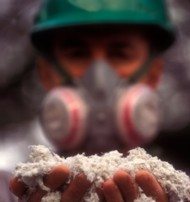The Hidden Mesothelioma Risk for Dentists
 Mesothelioma risk can sometimes be found in unexpected places. According to a newly-published article, dentists and others involved in casting prosthetics such as crowns and bridges prior to the 1970s may be at elevated risk for malignant pleural mesothelioma.
Mesothelioma risk can sometimes be found in unexpected places. According to a newly-published article, dentists and others involved in casting prosthetics such as crowns and bridges prior to the 1970s may be at elevated risk for malignant pleural mesothelioma.
Researchers from Queens College, City University of New York and Hofstra Northwell School of Medicine are reporting on six cases of malignant mesothelioma among dental professionals who were exposed to asbestos-containing dental tape in the process of making prosthetics.
Asbestos in the Dental Industry
Although dentistry is not a profession typically associated with asbestos exposure or mesothelioma risk, asbestos was used for decades to make the tape that lines dental casting rings during the making of various prosthetics.
Asbestos’ natural resistance to heat and flame made it an ideal material for lining these rings which are heated to high temperatures.
According to Dr. Steven Markowitz and Dr. Jacqueline Moline, the authors of the newly-published report, manufacturers of this lining tape started using chrysotile or “blue” asbestos in their tape beginning in the 1930s.
Mesothelioma and the Link to Asbestos
In the 1930s, asbestos was still believed to be a virtual “miracle product”, impervious to heat and corrosion, plentiful, and inexpensive. But concerns about the health effects of asbestos exposure began to surface as early as the 1940s and reached a peak in the 60s and 70s when the material was linked to deadly malignant mesothelioma.
Markowitz and Moline say it was around this time that the manufacturers of the dental lining tape stopped using asbestos. Unfortunately, some dental professionals had already been effected.
“We report six cases of pathology-verified malignant mesothelioma, mostly among dentists, following exposure to airborne dust from asbestos dental tape, which resulted in asbestos tort litigation,” states the article in the American Journal of Industrial Medicine, where Dr. Markowitz is also Editor-in-Chief.
Need for Comprehensive Exposure History
Cases of mesothelioma from to asbestos dental tape highlight the need for what Markowitz and Moline call “comprehensive exposure history” in any patient with mesothelioma-like symptoms.
While some professions, including shipbuilding, plumbing, asbestos mining, and construction, are more commonly associated with asbestos exposure, dentistry represents one of a number of industries with the potential for more subtle – but just as dangerous – exposure.
In recent years, pleural mesothelioma has been diagnosed in teachers who worked in older school buildings, in auto mechanics who worked on asbestos-containing brakes, and in firefighters who wore asbestos lined masks and protective gear.
Even consumers are not immune to the mesothelioma risk posed by exposure to asbestos. Home insulation, certain kinds of talcum powder, and even artificial snow used in Christmas decor once contained asbestos. All have been linked to cases of malignant pleural mesothelioma even decades after exposure.
Source:
Markowitz, SD and Moline, JM, “Malignant mesothelioma due to asbestos exposure in dental tape”, February 28, 2017, American Journal of Industrial Medicine, Epub ahead of print





